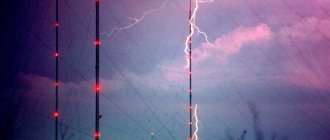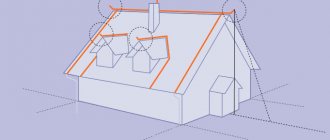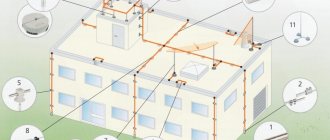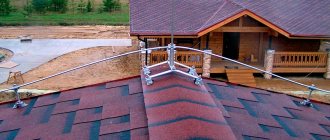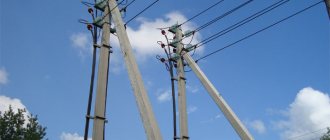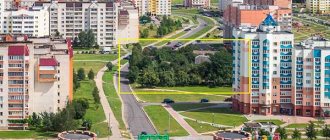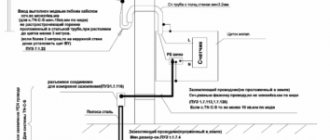Lightning protection means a special system of protection against lightning strikes, the impact of which can cause irreparable damage to any residential building or structure. It consists of a number of structural elements, each of which performs its own very specific function. Calculation of lightning protection therefore comes down to calculating the parameters of all components of the system, determined according to standard methods.
Purpose and composition of the system
To protect buildings from lightning discharges, so-called “passive” lightning protection is most often used, consisting of such structural elements as:
- lightning rod, equipped in the form of a metal pin, cable or special mesh structure;
- a current collector (descent) used to redirect the discharge to a grounding device (GD);
- the grounding structure itself.
Next, the main parameters of the lightning protection system to be calculated will be considered.
Lightning protection of buildings, structures, equipment and communications
Atmospheric phenomena with the formation of lightning, accompanied by bright flashes of light and thunder, are called thunderstorms. Lightning is a thunderstorm discharge of electricity that occurs between clouds and the Earth; inside the clouds.
Lightning strikes a house
Danger to human life, the safety of industrial and public buildings, high-rise engineering structures - chimneys, television antennas, radio communications, including cellular; towers, electrical network supports; technological equipment located on open industrial sites, for example, for distillation columns of oil refining enterprises, lightning is of the first type.
The need for lightning protection is due to the fact that the voltage during lightning discharges reaches 50 million V, and the current strength - up to 100 thousand A; with the release of huge amounts of light, sound and thermal energy. Lightning discharges are electrical explosions, similar to detonation, causing destruction to buildings, breaking trees that served as grounding sources; injure and concuss people, which often leads to their death.
Lightning protection is a set of technical solutions that reliably ensure the safety of people, the protection of buildings for various purposes, and high-rise objects; technological and engineering equipment of production facilities; communications infrastructure of populated areas, power lines, both from direct impacts of lightning discharges, electromagnetic, electrostatic induction, and from the transmission of electric current through metal structures, communications.
Grounding and lightning protection are what, according to the standards, industrial buildings, utility lines, and other facilities must be equipped with. In addition, paragraph 4 of Article 50 of Federal Law of the Russian Federation No. 123-FZ prescribes, as one of the ways to eliminate ignition sources, to arrange lightning protection for buildings and equipment to increase the level of fire safety at facilities.
Standards for lightning protection devices
Considering that buildings, structures, technological installations, communications are quite different in their design and execution, state, departmental, and corporate standards have been developed; standards, design rules for organizing optimal, effective lightning protection for each type of facility - from industrial facilities, where it was first used, to residential buildings.
The standards that regulate the creation of technical protection against lightning are based on experience in organizing the electrical safety of buildings of various types and purposes, taking into account the features inherent in modern buildings, structures and communications infrastructure and communications.
Requirements for lightning protection are set out in many official documents. Design and calculation of lightning protection is carried out on the basis of the following regulatory and technical framework:
- "Rules for electrical installations." Currently, the seventh and some chapters of the sixth edition of this fundamental document are in effect, without knowledge of the requirements of which it is impossible to design any types, types of electrical installations, equipment, equipment for protection against electric shock, including lightning protection. Industrial safety of protected objects with categories of explosion and fire hazard of premises and buildings is also impossible without this type of protection from high-voltage electric discharges. This takes into account the requirements for the organization and implementation of lightning protection for various types of buildings, engineering structures, electrical communications, specified in several chapters of the PUE. Chapters 2.4, 2.5 - for overhead power lines with an operating voltage of less than and more than 1 kV, respectively, including a zoning map of the territory of Russia indicating the duration of thunderstorms per year, which is necessary when designing lightning protection systems and devices. Chapter 4.2 – for switchgears, electrical substations with voltages greater than 1 thousand V. Chapter 4.3 – for converter substations, installations.
- RD 34.21.122-87 “Instructions for the installation of lightning protection of buildings and structures.” Its purpose is clear from the name. Despite the fact that the document was approved by the Ministry of Energy of the Soviet Union, in agreement with the State Construction Committee, it is still in force today.
- Some of its provisions have inevitably become outdated, not keeping up with scientific and technological progress, therefore, when designing modern technical systems and lightning protection devices, they use Russian GOSTs, which are identical to the standards of the International Electrotechnical Commission; as well as domestic instructions on lightning protection, published later.
- One of these documents SO 153-34.21.122-2003, developed by the same team of scientists, regulates the design of lightning protection for both buildings and infrastructure communications.
- GOST R IEC 62305-1-2010, GOST R IEC 62305-2-2010, which are two parts of one national standard on risk management when protecting facilities from lightning. The first part formulates general principles, the second – methods for assessing the risks of death and injury from electric shock to people; complete/partial destruction of objects, public communications; economic losses from lightning strikes.
- It is important that such factors as fire safety are considered, since the calculations take into account spaces with a flammable environment - an air mixture of vapors of flammable liquids, gases, and dust.
- GOST R IEC 62561.1-2014. This is the first part of the national standard on elements of lightning protection systems, concerning requirements for their parts and connections.
- GOST R IEC 62561.2-2014 – to conductors, grounding electrodes.
- GOST R IEC 62561.3-2014 – for distribution arresters.
- GOST R IEC 62561.4-2014 – for fastening elements.
- GOST R IEC 62561.5-2014 – for inspection wells, seals of grounding electrodes.
Requirements for the design, grounding, lightning protection of electrical installations, building equipment, power lines in the USSR were also established by SNiP 3.05.06-85 on electrical devices. Today there is a set of rules in force, issued as its updated version - SP 76.13330.2016.
In addition to the standards in force on the territory of the Russian Federation, similar requirements for lightning protection systems applied in the allied states should be mentioned. In the Republic of Kazakhstan, this is SP RK 2.04-103-2013 on the design of lightning protection of objects, issued to replace a similar instruction SN RK 2.04-29-2005; in the Republic of Belarus - technical code TKP 336-2011 on lightning protection of objects and utilities.
Type of lightning protection zones
Lightning protection systems for objects, engineering, communications and technological equipment are understood as external and internal technical devices that allow them to be protected both from the direct impact of lightning strikes and from secondary impacts - electric, electromagnetic fields that accompany a lightning discharge.
There are active and passive lightning protection systems.
Passive , capable of intercepting lightning before it discharges on the structure of a construction site, equipment body or part of an engineering, communications structure, and discharging the charge into the ground, consists of the following elements:
- Lightning receiver.
- Lightning rods.
- Grounding devices.
In an active system, these integral elements are supplemented by devices that generate an upward flow of ions that attracts a lightning discharge.
Several types of lightning protection systems are designed and installed - rod, cable, which, based on the results of calculations, depending on the number of rods/cables, their arrangement/location, configuration of the protection area, can create two types of lightning protection zones:
- A. The degree of protection reliability is from 99.5%.
- B – from 95%.
Types of lightning protection systems
In practice, if a construction site, technological installation, tower, pole, utility antenna is completely located in the zone of protection from lightning strikes, the probability of them being damaged by a lightning electric discharge tends to zero.
Classification of buildings and structures by lightning protection device
There are the following categories of lightning protection for construction sites , depending on the purpose, significance, fire hazard class and the possibility of explosion; fire load – presence, quantity, type of explosive and fire hazardous materials; regional frequency of lightning discharges; recorded lightning strikes:
- Category I , which has the highest level of protection against a possible direct lightning strike on an object. These are production facilities with explosive zones of hazard classes B-I, II. Protection zone type – A.
- II category . These are industrial and warehouse buildings, open areas for storing flammable liquids, flammable liquids, and with technological equipment installed on them, where they are circulated; as well as explosive production, outdoor installations with hazard class below B-Ia. Type of protection zone for process equipment installed on open industrial sites – B; for objects - A or B, depending on the predicted number of lightning discharges per year.
- III category . This includes construction projects for various purposes with III–V degrees of fire resistance in areas where the annual duration of thunderstorms is more than 20 hours. The main type of lightning protection is B.
All the main parameters of the lightning protection system for any specific facility can be determined using Table 1 of RD 34.21.122.
Types of lightning protection
Depending on the category of objects, the lightning protection system can be of several types:
- Protects against direct impacts. The devices used for this are called lightning rods, consisting of a load-bearing support, which can be the building itself, a discharge receiver, a down conductor and a grounding conductor. Both rod and cable lightning rods and metal mesh laid on the roof of the protected object are used. For overhead power lines, lightning protection cables are used to absorb lightning strikes.
- From electrostatic induction. This is done by connecting all electrical equipment to the facility’s grounding system.
- From electromagnetic induction. To do this, conductive jumpers are installed at the junction points between sections of pipelines and overpasses.
- From the drift of electric potential caused by a lightning discharge. To do this, all communications entering buildings and structures, including the metal sheath of electrical cables with voltages up to 1 thousand V, are grounded. Overhead power lines at the approaches to the facility are equipped with lightning protection cables, and arresters and surge suppressors are mounted on the supports.
Means and methods of lightning protection
The means of protection against electrical lightning discharges include:
- rod lightning receivers;
- lightning protection cables;
- mesh lightning rods;
- down conductors;
- grounding contours of construction sites.
There are two types of lightning protection options:
- External, protecting from the direct impact of a high-potential electrical discharge that can cause destruction, explosions and fires, due to its discharge into the ground to dissipate energy.
- Interior. For protection against secondary factors of direct or close to the protected object lightning strike. For this purpose, various types of special devices are used, called SPDs - surge protection devices.
Lightning protection of a building
Installation of lightning protection and testing of lightning protection upon completion of installation work is carried out by organizations performing electrical work.
Operation of lightning protection does not require additional costs and is designed for a long period. But inspection of lightning protection for detection of mechanical damage to discharge receivers, current-carrying, grounding elements, and connections between them is still required.
Checking lightning protection allows facility owners, management of enterprises, and organizations to be confident that it will not fail during a dangerous thunderstorm period.
Lightning rod and descent
As for the first component of lightning protection (lightning rod), the requirements of the PUE stipulate that it should be located at the highest point of the protected structure.
For standard pin-class structures, the location of this element is selected based on the fact that the pointed end of its peak is 2-3 meters above the plane or ridge of the roof.
If there are several pin lightning rods on the protected object, according to the generally accepted methodology, the distance between adjacent lightning rods must be calculated.
In the case of using a cable or mesh lightning rod, for the corresponding lightning protection elements, calculations are made of either the main parameters of the cable (length and cross-section) or the dimensions of an individual mesh cell.
It is not recommended to use longer lightning rods, since they will begin to attract even those lightning discharges that do not threaten the given object in any way.
A down conductor is necessary to redirect the electrical discharge received by the lightning rod in the direction of the grounding device. On the one hand, it is connected to the lightning “catcher”, and on the other, to the ground electrode structure.
Its main calculated values are the material of the outlet tape, its length and cross-section, which ensure the lowest electrical resistance of the outlet chain.
From the point of view of calculating the system, in order to achieve the required result, this element must be made of metals with high electrical conductivity and have a sufficiently large cross-section (usually 6-8 sq. mm).
Grounding device
The grounding structure for lightning protection is calculated based on the requirement to achieve reliable contact with the ground, providing ideal conditions for the spread of a current discharge into the ground.
Particular attention must be paid to the calculation of this part of lightning protection, since without reliable grounding all other elements of the protective system lose their functionality.
Before calculating the lightning protection grounding loop, it should be noted that its structure is made of thick metal pins, pipes or steel profiles (channels) driven vertically into the ground.
Their length and cross-section are determined by calculation based on the requirements of creating ideal conditions for the lightning current to flow into the ground.
In addition, design grounding elements also include steel jumpers that combine rods driven into the ground into a single circuit and are connected by welding. Their design parameters are length and cross-section, as well as steel grade, which provide the required spreading resistance.
The next section provides an example of calculating a lightning protection system.
An example of grounding calculation on a calculator
Let's assume that our house is located on chernozem soils with a layer thickness of 0.5 m. We live in the south of Russia in the fourth climatic zone. Presumably, 5 vertical electrodes with a diameter of 0.025 m and a length of 2 m will be used as grounding electrodes, horizontal rods at a depth of 0.5 m - 2 m long with a shelf width of 0.05 m.
Then, by transferring all the values into the grounding calculator, we get a total spreading resistance of 4.134 Ohms.
If our private house has a single-phase network with a voltage of 220 W, then this value is unacceptable, since this grounding will not be enough .
Let's add another vertical electrode and get a value of 3.568 Ohms. This value is quite suitable for us, which means that such grounding is guaranteed to protect your building and its inhabitants.
If you get a value close to critical, then it is better to increase the number or size of electrodes. Remember that calculating the ground loop is extremely important for safety!
